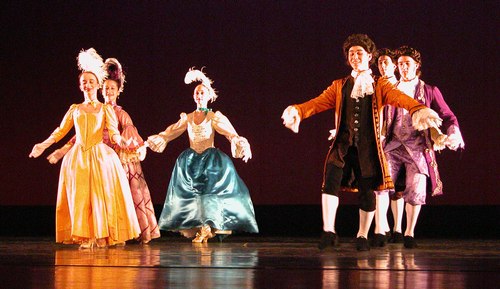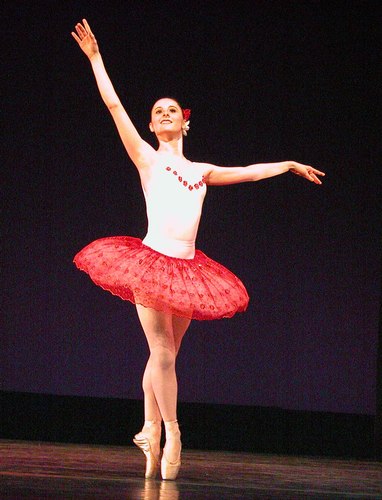|
 |
|
|
 |
 |
(See an Interview with Francois Perron and Deborah Wingert's Ballet Class)
(See Ballet Class Photos of Studio Maestro)NOTES FROM FRANCOIS PERRON: In 1661 Louis XIV of France established the Academie Royale de Danse, now known as the Paris Opera. Pierre Beauchamps, the king's dancing master, conceived the five basic positions of the feet that we use in ballet today, and codified the balletic form. This noble style of dance established, maintained, and promoted social class. Couples and the symmetrical floor patterns of their dance were scrutinized for elegance, sophistication, grace, glamour, and style. The court minuet traveled across oceans to England, and was even performed in the United States by George Washington. And just as we today regard the Louis Vuitton purse, the pop of a Moet et Chandon cork, or jeans topped with a jacket from Chanel as the quintessence of French style, so did Europeans and Americans in the 17th and 18th century.
With our "Suite from Naïs", we present the epitome of French baroque theatrical style. By 1830, costumes had been shortened, legs were lifted higher, and removing some of the corseting allowed the torso to be more supple and expressive. Audiences appreciated "elegant virtuosity", to see movements done with ease and grace. Choreographers created dances with props like garlands, wreaths, and fabric, and in our "Five Dances," you will see how the dancers and fabric were used to create theatrical illusions. As you watch, look for things you recognize: steps still present in the ballet vocabulary, patterns, and conventions from ballets like "Giselle" or "Swan Lake". Then ask yourself: what is different? As we reflect on the history of dance, we can learn about our present by observing the past - what we have gained, what we have lost, and what we can recover to imbue the dance with new life from the old.Program:What a wonderfully professional program for the exemplary ballet school, Studio Maestro, on Manhattan's Upper West Side, near Lincoln Center. The Studio will move into new quarters in the 2007-2008 school year, with 18,000 square feet of space and many new programs and facilities. But, the essence of this extraordinary classical and classy ballet school will always exist. One can see the detail that went into the lovely costumes and the handmade school films (with pulsating creativity), as well as the poise and presence of each and every student, to know that Studio Maestro's staff is exceptionally dedicated and seasoned in the ballet genre. One can also see that this staff has developed successful educational methods. From the tiniest tots to the pre-professionals, today's performers have the potential to grace any stage at Lincoln Center, City Center, or The Joyce in the future. Episodes (excerpt): Choreography: George Balanchine, Music: Anton Webern, Staged by: Deborah Wingert. Performed by Jessica Black, Truett Thurow, Julianne Benedetto, Alexandra Black, Kimberly Braylock, Pauline Dunoyer, Rachel Fallon, Emily Gnatt, Emma Lobenhofer, Danielle Maas, Claire Mazza, Serena Mackool, Caroline Mills, Elisabeth Moulic, Kellyann Pintauro, and Allison Sharkey. The performance of Episodes (excerpt), a Balanchine® Ballet, is presented by arrangement with The George Balanchine Trust_ and has been produced in accordance with the Balanchine Style® and Balanchine Technique®, service standards established and provided by the Trust. (Program Notes). Episodes, George Balanchine's 1959 masterpiece, often reviewed at City Ballet, was staged with the authentic black leotards and pink tights, so evocative of signature Balanchine imagery. My first impression of the Studio Maestro students was that each dancer exuded the appropriate affect: intense, engaged with the audience, balanced, and symmetrically sound. In fact, Deborah Wingert's choreography was perfected to facial gesture and position of the head and torso. Jessica Black is a dancer to watch, as she kept my eye on her well-positioned pointe shoes. The one male dancer, Truett Thurow, was experienced in partnering and utilized fancy footwork. Webern's music calls for serious dance, and serious dance this was. Don Quichotte Variation: Choreography: Marius Petipa, Music: Leon (Ludwig) Minkus, Performed by Nicole Graniero (Studio Maestro alumna, courtesy of American Ballet Theatre). Nicole Graniero, reviewed in this magazine in a 2005 ABT Gala, illustrates the fine training at Studio Maestro, as this brief but challenging solo was timed to perfection, and Ms. Graniero succeeded in capturing the energy of the crowd. Her fan and fancy tutu whirled by with rapid footwork and elegance. Suite from Naïs (Courtesy of Historic Dance Theatre): Choreography: Tom Baird (after 18th Century sources), Music: Jean-Philippe Rameau, Performed by Anna Bella Bernstein, Alexandra Black, Emily Gnatt, Michael Horne, Maxwell Schneider, and Chadbourne Stonehocker. Here three female students in long ball gowns (I have never seen such costume finery in a student ballet recital.), wearing character shoes with ribbons and historical wigs, were partnered by three male students, also in wigs, with britches, Baroque shoes, and high stockings. The brightly colored costumes enhanced the Rameau score, while the ornately attired dancers proudly performed with theatricality and skill. (See above French Historical Dance Notes by François Perron). Five Dances (Courtesy of Historic Dance Theatre): Choreographic reconstruction: Robert Atwood, Music: Franz Schubert German Dances (excerpts), Historical re-creation based on the illustrations of Franz Opfermann, Sr. (c.1830), courtesy of the Della de Moroda Dance Archives, Salzburg, Austria. Historical research and oversight by Prof. Claudia Jeschke, University of Salzburg. Performed by Julianne Benedetto, Jenna Lauter, and Sarah Smith. (See above French Historical Dance Notes by François Perron). Three female dancers with "Isadora Duncan – sized" scarves used the two silk props to advantage, as shawls, as backdrops, as décor. Authentically classical steps were on display with Robert Atwood's choreographic reconstruction. The Historic Dance Theatre foundation worked with Studio Maestro to help create this and the dance above. Raymonda: Choreography: Daniel Baudentistel, Music: Alexander Glazounov, Performed by Rachel Fallon, Danielle Maas, Douglas Horne, Kimberly Braylock, Claire Mazza, Allison Sharkey, Maryalice Aymong, Julianne Benedetto, Alexandra Black, Emily Gnatt, Kellyann Pintauro, Emma Lobenhofer, Caroline Mills, Elisabeth Moulic, Raoul Boisset-Fray, Jacob Hiss, Michael Horne, and Maxwell Schneider. In new Raymonda choreography, designed by Studio Maestro's Daniel Baudentistel, led by an ensemble of six and a corps of twelve, pink tutus flowed easily. Douglas Horne is a dancer to watch, with curly hair and an ease with elevation, long leaps, and daring gravity-defying motion. Rachel Fallon and Danielle Maas have mastered stage presence, technical styling, and audience engagement. Harlequinade: Choreography: Marius Petipa, Jean Dauberval, Music: Riccardo Drigo, Ferdinand Herold, Staged by: Marina Stavitskaya, Performed by Maryalice Aymong and Douglas Horne. Once again, Douglas Horne was astounding in his pas de deux with Ms. Aymong. Both dancers, she in a black hat and white/black tutu, and he in typically harlequin-colored tights, leaped and spun about with talent beyond their years. In fact, Mr. Horne has mastered fast scissors-kicks, en air, and he seemed truly delighted in this mastery. Marina Stavitskaya succeeded in precisely timed staging to the effervescent Drigo/Herold score. Dance with: Choreography: Bryan Arias-Diaz (Studio Maestro alumnus courtesy of Complexion), Music: Joaquin Rodrigo, Performed by Kimberly Braylock, Rachel Fallon, Danielle Maas, Serena Mackool, Caroline Mills, Douglas Horne, and Chadbourne Stonehocker. All afternoon, I was mesmerized by the professional lighting design (Farley Whitfield), but Dance with was the pièce de resistance. With bright red lights, dancers in black leotards or black pants appeared in shadowed silhouette, forming human designs against the iridescent backdrop. Rodrigo's flamenco score infused the stage, as the lighting merged brighter, and the five females and two males drew the audience in. The choreography is by a Studio Maestro alumnus, Bryan-Arias-Diaz, courtesy of Complexion, and he, too, has a bright future. Winter: Choreography: Daniel Baudentistel, Music: Alexander Glazounov, Performed by FROST: Alexandra Black, Emma Lobenhofer, SNOW: Ariele Block, Jaimie Cooper, Catherine Cumming, Lauran Kellam, Krista Nunn, Cynthia Ohkawa, Jacqueline Schiller, Kika Ziesk-Socolov, ICE: Jenna Lauter, Sarah Smith, HAIL: Mary Attaway, London Barreras, Paris Calcagnini, Georgia Cohen, Riana Erickson, Nora Massie, Sophia Massie, Hanna Schlesinger, Christina-Zhen Urban, Michael Greenberg, Matthew Lobenhofer, and Hans-Sebastian Palacios. Finally the tiny tots appeared, along with the older, elementary-age dancers, and they were all delightful, paired with the older students in this very white, winter medley of small and large ensemble choreography (also designed by Daniel Baudentistel). Glazounov's music never seemed better, and the hand motion for snow and hail was reminiscent of Balanchine's "Dance of the Snowflakes". Each group of dancers, Frost, Snow, Ice, and Hail, danced independently and in unison, and the students never lost space, mood, poise, footing, or energy. This was the end of a three-performance weekend, and each dancer was buoyant and balanced. Paquita: Choreography: after Marius Petipa, Music: Leon (Ludwig) Minkus, Staged by: Marina Stavitskaya, Performed by Maryalice Aymong, Julianne Benedetto, Jessica Black, Kimberly Braylock, Pauline Dunoyer, Rachel Fallon, Emily Gnatt, Danielle Maas, Serena Mackool, Claire Mazza, Caroline Mills, and Allison Sharkey. 1st Variation: Danielle Maas, 2nd Variation: Jessica Black, 3rd Variation: Pauline Dunoyer, 4th Variation: Cecilia Iliesiu, 5th Variation: Maryalice Aymong, 6th Variation: Kimberly Braylock, 7th Variation: Serena Mackool. As a finale, Marina Stavitskaya staged a full female ballet with no less than seven variations. Danielle Maas, Jessica Black, Pauline Dunoyer, Cecilia Iliesiu, Maryalice Aymong, Kimberly Braylock, and Serena Mackool were astounding in their internalized interpretations of the variations. Soulful strings filled the Concert Hall, as the full compliment of twelve ballerinas, in red/white, black/pink, and black/white tutus and flowered hair soared and spun about with pride and power. Kudos to Rose Caiola, François Perron, choreographers, rehearsal coordinators, and lighting/sound/costume designers. And, kudos to the ballet students of Studio Maestro, with bright futures ahead. .
 Episodes
Choreography: George Balanchine Photo © & courtesy of Robert Abrams |
|
 Don Quichotte Variation
Choreography: Marius Petipa Photo © & courtesy of Robert Abrams |
|
 Suite from Naïs
Choreography: Tom Baird (after 18th Century sources) Photo © & courtesy of Robert Abrams |
|
 Five Dances
Choreographic reconstruction: Robert Atwood Photo © & courtesy of Robert Abrams |
|
 Raymonda
Choreography: Daniel Baudentistel Photo © & courtesy of Robert Abrams |
|
 Harlequinade
Choreography: Marius Petipa, Jean Dauberval Photo © & courtesy of Robert Abrams |
|
 Dance with
Choreography: Bryan Arias-Diaz Photo © & courtesy of Robert Abrams |
|
 Winter
Choreography: Daniel Baudentistel Photo © & courtesy of Robert Abrams |
|
 Paquita
Choreography: after Marius Petipa Photo © & courtesy of Robert Abrams |
|
 Silent Auction and Raffle Photo © & courtesy of Robert Abrams |
|
 Candids
Rose Caiola, Executive Director and Founder of Studio Maestro Photo © & courtesy of Dr. Roberta E. Zlokower |
|
 Candids
Francois Perron, Managing Artistic Director, and Deborah Wingert, Teacher and Choreographer Photo © & courtesy of Robert Abrams |
|
|
|














